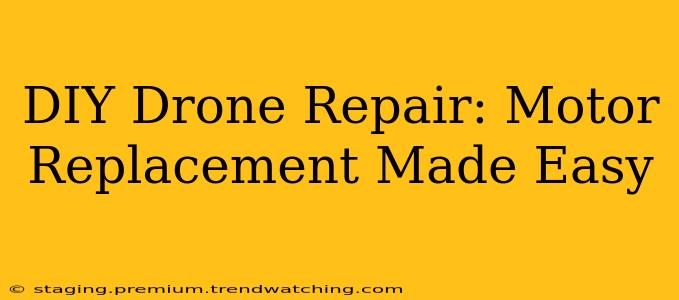So, your drone has taken a tumble, and now one of its motors is sputtering or refusing to spin? Don't panic! Replacing a drone motor is a manageable DIY project, even for beginners with some basic technical skills. This guide will walk you through the process, equipping you with the knowledge to get your drone back in the air. We'll cover everything from identifying the problem to safely completing the repair, ensuring you save money and gain valuable experience in drone maintenance.
Why Replace a Drone Motor Yourself?
Drone repair shops can charge hefty fees, especially for seemingly simple fixes like motor replacements. DIY repair offers significant cost savings and allows you to learn more about your drone's inner workings. Furthermore, tackling this project yourself empowers you to troubleshoot future issues and keep your drone flying longer.
What Tools Do I Need for Drone Motor Replacement?
Before you begin, gather the necessary tools. This will make the process smoother and less frustrating. You'll typically need:
- A replacement drone motor: Ensure you purchase a motor compatible with your specific drone model. Incorrectly matched motors can cause performance issues or damage.
- A small Phillips head screwdriver: This is essential for unscrewing and securing the motor mounts.
- Tweezers or small pliers: These are helpful for delicate tasks, such as handling small screws or connectors.
- A multimeter (optional): Useful for testing the motor's continuity after installation, ensuring it's functioning correctly.
- Gloves: Protect your hands from dirt and potential damage.
How Do I Identify a Faulty Drone Motor?
Identifying the problematic motor is the first crucial step. Common symptoms of a bad motor include:
- Unusual sounds: Grinding, buzzing, or clicking noises during operation indicate a problem.
- Unresponsive motor: The motor may not spin at all or respond poorly to commands.
- Erratic flight behavior: The drone might tilt, vibrate excessively, or have difficulty maintaining altitude.
By visually inspecting your drone and testing each motor individually, you can pinpoint the faulty component.
What if My Drone Motor Isn't Spinning?
A non-spinning motor could be due to several reasons:
- Faulty motor: This is the most common culprit and requires a replacement, as described in this guide.
- Loose wire connections: Check for loose or damaged wires connecting the motor to the flight controller. Reseat or repair them if necessary.
- Problem with the ESC (Electronic Speed Controller): The ESC regulates the power to the motor. If the ESC is malfunctioning, it won't send power to the motor, even if the motor itself is good. Replacing the ESC might be necessary.
- Flight controller issues: In rare cases, a problem with the flight controller itself can prevent a motor from spinning. This requires more advanced troubleshooting or professional assistance.
Step-by-Step Guide to Replacing a Drone Motor
- Disassemble the drone: Carefully remove the propellers and any other components hindering access to the motor. Follow your drone's specific instructions for disassembly.
- Disconnect the wires: Gently disconnect the wires from the faulty motor. Take photos or make notes to remember the correct order when reconnecting.
- Remove the faulty motor: Unscrew the motor mount and carefully remove the damaged motor.
- Install the new motor: Secure the new motor into the mount and screw it tightly. Make sure the motor is correctly aligned.
- Reconnect the wires: Connect the wires from the new motor, making sure they're correctly positioned. Double-check your work against the earlier photo or notes.
- Reassemble the drone: Carefully put everything back together, ensuring all parts are secure.
- Test the motor: Before flight, test the motor individually using your drone's calibration procedures or a dedicated motor tester. If you have a multimeter, check for continuity.
- Test flight: Perform a short test flight in a safe, open area to verify the repaired motor is functioning correctly.
Safety Precautions When Repairing Your Drone
- Always work in a clean and well-lit area.
- Disconnect the drone's battery before starting any repair.
- Avoid touching the motor's windings or internal components.
- Use the correct tools to avoid damaging components.
- Consult your drone's manual for specific instructions.
This comprehensive guide empowers you to tackle drone motor replacement with confidence. Remember, patience and attention to detail are key to a successful repair. If you're unsure about any step, seeking help from online forums or experienced drone enthusiasts is always a good idea. Happy flying!

